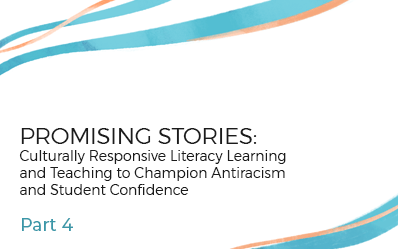Promising Stories, Part 4: Reflection, and Outside Learning as an Avenue for Inside Learning
This is the fourth in a multi-part series by Laura Benson, ISS Director of Curriculum and Professional Development. Find other installments here: Part 1, Part 2, Part 3, Part 5, Part 6.
Promising Stories: Culturally Responsive Literacy Learning and Teaching to Champion Antiracism and Student Confidence
Culture is like the air we breathe, permeating all we do. And the hardest culture to examine is often our own, because it shapes our actions in ways that seem invisible and normal. What feels “normal,” Small (1998) reminds us, is molded by deeply ingrained social habits and ways of valuing and evaluating what we are scarcely aware of. This is what implicit bias is in a nutshell.
Zaretta Hammond, Culturally Responsive Teaching and the Brain
Reflection
In order to create a learning environment that authentically supports racial diversity, educators can start with self-reflection (Armstrong, 2020). Understanding oneself will reveal educators’ feelings, thoughts, and attitudes about race and how they influence interactions and expectations with students (Delpit, 2006). To nurture reflection and to strengthen identity and self-awareness, I often share and use Visible Thinking routines and protocols with students – kids and adults. “I used to think…but now I think…” was a frequent reflection ritual in my own classroom and as I learn with educators around the world, too.
For a million examples and ways to engage your own learners in vital reflection, please see the work of Ron Ritchhart and Mark Church (2020) in The Power of Making Thinking Visible: Practices to Engage and Empower All Learners and through these websites: Visible Thinking and Thinking Routine Toolbox from Harvard’s Project Zero.
Outside Learning as an Avenue for Inside Learning
If we can look at how students successfully engage in learning outside of school, we gain insights about how to build relevant and motivating learning for them in school. Culturally responsive teachers build bridges of meaningfulness between students’ home and school experiences as well as between students’ academic abstractions and lived sociocultural realities (Gay, 2000). Via classroom conversations, one on one conferences, and family and community interviews, understand how your students learn outside of school. Students’ cultures of learning outside of school can bridge how they learn academic subjects inside of school. For example, consider students’ faith learning. If students engage in daily prayers at their mosque, study for their confirmation, or deepen their understanding about their faith and heritage in Hebrew School, they likely use repetition, recitation, stories, parables or analogies, and music in their learning. Infusing these practicing into our teaching practices, we can utilize students’ familiar and confident ways of learning as they study new content in their literacy, math, or other content area learning.
Likewise, if students are engaged in sports, a team approach to learning inside of school can make their academic pursuits feel more motivating and worth the risk of trying new skills. Additionally, students involved in sports are accustomed to having their coach show them how to do something and provide feedback about their own executions of a demonstrated skill. Think alouds and modeling feel like kindred spirits to many of our student athletes.
Students in boy scouts and girl scouts learn through hands-on experiences, service projects, and with rituals. Likewise, hands-on learning and authentically doing learning with project-based learning and inquiry models such as those profiled by the Common Ground Collaborative help students use previously success experiences to inform new learning.
Music is another arena which we can draw from to help students make connections from their outside of school learning to their learning of reading, writing, math, etc. Growth in music depends, in part, on a learner’s repetition of a song, scale, chorus, etc. Wise music teachers give students the “whole version” of a song to be learned by playing the song for students as a demonstration, model, exemplar, and inspiration. Music teachers often chunk a larger piece into manageable learning “bits” to enable students to understand each verse (for example) and build up their confidence. In music lessons, many students experience guided practice, too, when the teacher and a student play a piece together or echo one another. And thoughtful music teachers always help students integrate the bits of their music learning into a whole version and frequently encourage students to create their own interpretation of a composer’s piece. Thus, we can draw on students’ music learning practices and skills such as modeling, active listening, and inferring to edify their academic learning.
All installments of the Promising Stories series can be found here:
- Part 1: Introduction
- Part 2: It Starts With Stories…Your Stories, My Stories, Our Stories
- Part 3: Culture Connections, and Build on Students’ Strengths
- Part 4: Reflection, and Outside Learning as an Avenue for Inside Learning
- Part 5: Books are Mirrors and Windows
- Part 6: It’s All About Relationships
View References and Resources for Developing Culturally Responsive Learning and Nurturing Antiracism
You can also follow Laura at @lbopenbook, plus view her curated antiracism padlet here.







